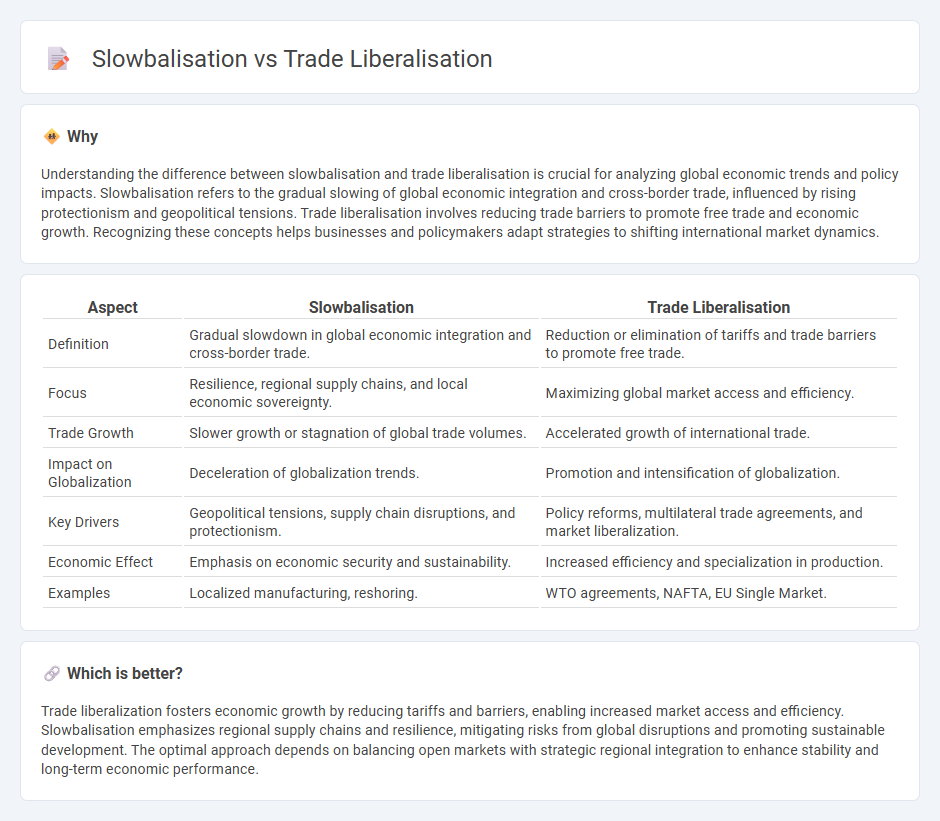
Slowbalisation reflects the gradual deceleration of global economic integration, characterized by reduced cross-border trade growth and reshaped supply chains. Trade liberalisation promotes the removal of tariffs and barriers, fostering increased international commerce and market access. Explore the impacts and future trends of these contrasting economic phenomena to better understand global market dynamics.
Why it is important
Understanding the difference between slowbalisation and trade liberalisation is crucial for analyzing global economic trends and policy impacts. Slowbalisation refers to the gradual slowing of global economic integration and cross-border trade, influenced by rising protectionism and geopolitical tensions. Trade liberalisation involves reducing trade barriers to promote free trade and economic growth. Recognizing these concepts helps businesses and policymakers adapt strategies to shifting international market dynamics.
Comparison Table
| Aspect | Slowbalisation | Trade Liberalisation |
|---|---|---|
| Definition | Gradual slowdown in global economic integration and cross-border trade. | Reduction or elimination of tariffs and trade barriers to promote free trade. |
| Focus | Resilience, regional supply chains, and local economic sovereignty. | Maximizing global market access and efficiency. |
| Trade Growth | Slower growth or stagnation of global trade volumes. | Accelerated growth of international trade. |
| Impact on Globalization | Deceleration of globalization trends. | Promotion and intensification of globalization. |
| Key Drivers | Geopolitical tensions, supply chain disruptions, and protectionism. | Policy reforms, multilateral trade agreements, and market liberalization. |
| Economic Effect | Emphasis on economic security and sustainability. | Increased efficiency and specialization in production. |
| Examples | Localized manufacturing, reshoring. | WTO agreements, NAFTA, EU Single Market. |
Which is better?
Trade liberalization fosters economic growth by reducing tariffs and barriers, enabling increased market access and efficiency. Slowbalisation emphasizes regional supply chains and resilience, mitigating risks from global disruptions and promoting sustainable development. The optimal approach depends on balancing open markets with strategic regional integration to enhance stability and long-term economic performance.
Connection
Slowbalisation reflects a deceleration in the expansion of global trade and investment flows, often influenced by geopolitical tensions and rising protectionism. Trade liberalisation aims to reduce tariffs and barriers, promoting increased cross-border economic integration, but its momentum has been challenged by the factors driving slowbalisation. The interplay between slowbalisation and trade liberalisation shapes the current global economic landscape, affecting supply chains, foreign direct investment, and international cooperation frameworks.
Key Terms
Tariffs
Trade liberalisation involves reducing or eliminating tariffs to promote cross-border commerce and economic integration. Slowbalisation signifies a deceleration in global trade growth, with countries often reimposing tariffs to protect domestic industries and prioritize supply chain resilience. Explore the evolving impact of tariffs on global trade dynamics to understand these contrasting trends in depth.
Global supply chains
Trade liberalization accelerates global supply chains by reducing tariffs and non-tariff barriers, fostering efficiency and interconnectivity among international producers. Slowbalisation reflects a strategic shift towards regionalization and reshoring, emphasizing supply chain resilience and risk management amid geopolitical tensions. Explore how these dynamics reshape the future of global trade and supply networks.
Protectionism
Trade liberalization promotes the reduction of tariffs and trade barriers to foster global economic integration, enhancing market access and competitiveness. In contrast, slowbalisation reflects a trend toward increased protectionism, with countries imposing stricter regulations and tariffs to safeguard domestic industries amid geopolitical tensions. Explore how evolving policies in protectionism influence global trade dynamics and economic strategies.
Source and External Links
Explaining the trade reform wave of 1985-1995 - CEPR - Trade liberalisation in 1985-1995 involved many developing countries reducing import restrictions and adopting market-oriented policies, accompanied by regional and multilateral agreements like NAFTA and the WTO's creation in 1995, focusing on exchange rate policies and gradual tariff reduction.
The Future Course of Trade Liberalization | PIIE - Trade liberalisation generates significant gains from more efficient specialization and exchange of goods and services, benefiting countries by allowing them to export goods they produce relatively efficiently and import those produced less efficiently.
Shifting Views on Trade Liberalisation: Beyond Indiscriminate Applause - Since WWII, continuous global trade liberalisation under GATT and WTO has lowered tariffs, increased consumer choices, reduced prices, and played a key role in lifting millions out of poverty, notably in Asian emerging economies including China.
 dowidth.com
dowidth.com